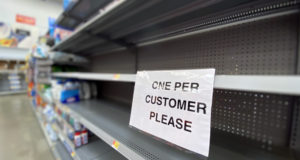Many investment experts believe that a major decline or even crash in the stock, real estate and bond markets is imminent – despite what the Dow Jones is telling us.
The Dow jumped more than 300 points Tuesday to finish above 21,000 – a record – but if you dig a little deeper you’ll discover that things aren’t all that rosy.
In fact, some of the smartest brains on Wall Street are convinced that a major fall is just around the corner.
Jim Rogers, George Soros’ partner in the Quantum Fund, believes a $68 trillion crash will occur in 2017 or 2018, Investopedia reported. Swiss economist Marc Faber has said the market will fall after the S&P 500 (an index of stocks in America’s 500 largest corporations) hits 2,300; the S&P was at 2,390 early Wednesday.
Are You Prepared For A Long-Term Blackout? Get Backup Electricity Today!
“Get prepared,” Rogers said in an interview with MacroVoices. “We’re going to have the worst economic problems we’ve had in your lifetime or my lifetime and when that happens a lot of people are going to disappear.”
Here are five good reasons why you should be afraid of the current bull market:
1. The increase in stock prices is largely artificial. Stock prices are rising because corporations are using their own cash to buy back their own stocks. Companies spent $500 million on stock buybacks between 2014 and 2016, HSBC analysts determined. Since 2010, corporate America has spent $2.1 trillion on stock buybacks. Walmart alone has plans to repurchase $15 billion worth of its stock. When the buybacks end, stock prices will fall back to earth.
2. The increase in stock and real estate prices over the last seven years has been driven largely by the Federal Reserve’s printing of money. This is done by keeping interest rates artificially low, which spurs borrowing. If the fed raises interest rates, the boom will end and real estate and stock prices will collapse. The Fed started raising interest rates on Dec. 14, and many observers think it will keep doing so to prevent inflation.
3. Economic activity and the number of jobs are actually declining. Massive cutbacks are taking place in some industries, including retail. JC Penney last week announced plans to close 130 to 140 stores — 14 percent of its operations — and eliminate 6,000 jobs. Macy’s is closing 100 of its stores and Sears is closing 150 stores, including 108 Kmarts. Walmart eliminated 7,000 back office jobs last year and is laying off 1,000 people at its headquarters. And it’s not just retail; last year; Bank of America closed 112 branches, Citibank closed 116 locations and JPMorgan Chase shuttered 161 branches.
4. There are similarities between today’s market and 1987. That year, the Dow lost 30 percent of its value in a crash. Experts told CBS that the Dow hit 10 record highs in 1987, and then crashed after the Federal Reserve raised interest rates. Another similarity: Some investors’ might have unrealistic expectations about President Trump and Congress. Back in 1987, the market was expecting tax cuts that did not occur for more than a year.
5. Some investors have quietly cashed out of the market or parts of it. Warren Buffett sold all of his Exxon Mobil stock last year and got rid of $900 million worth of Walmart stock this year. Nor is it just Buffett; prices in alternative investments that speculators use as a hedge or protection against market losses are going up. Gold prices soared to $1,250 an ounce on Feb. 24, and bitcoin reached a high of $1,204.77 on the same day. That’s a sure sign that investors are looking seriously at liquid investments.
What do you think? Share your thoughts in the section below:
Bust Inflation With A Low-Cost, High-Production Garden. Read More Here.
 Off The Grid News Better Ideas For Off The Grid Living
Off The Grid News Better Ideas For Off The Grid Living



